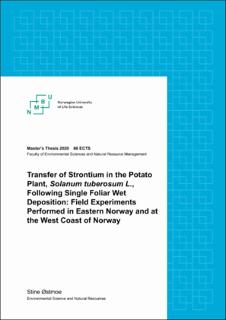| dc.contributor.advisor | Teien, Hans-Christian | |
| dc.contributor.advisor | Salbu, Brit | |
| dc.contributor.advisor | Jensen, Karl Andreas | |
| dc.contributor.author | Østmoe, Stine | |
| dc.coverage.spatial | Norway | en_US |
| dc.date.accessioned | 2020-09-18T13:40:54Z | |
| dc.date.available | 2020-09-18T13:40:54Z | |
| dc.date.issued | 2020 | |
| dc.identifier.uri | https://hdl.handle.net/11250/2678558 | |
| dc.description.abstract | 90Sr is one of the most important and frequent radioactive products from nuclear fission. If ingested, it is considered a major hazard to humans due to high retention in skeleton, leading to irradiation of cells and cancer development. The ecosystem behavior of 90Sr is of great interest for countermeasure implementation after potential fallout scenarios where the aim is to understand and predict transfer in agricultural plants grown for consumption. This study used a known Sr-isotopic composition (84Sr/87Sr) to follow uptake and transfer of Sr in the potato plant, Solanum tuberosum L., after single foliar wet deposition. Agricultural fields at two different NIBIO Research stations; Apelsvoll, situated in the east and Fureneset, situated at the western coast were used for potato cultivation to study how variation in climatic conditions and soil characteristics affect transfer of Sr. The main objectives were to (i) investigate if Sr concentration on foliage would be reduced over time, (ii) quantify and differentiate transfer of Sr at Apelsvoll and Fureneset, (iii) identify where in the potato tubers Sr would accumulate and (iv) determine if translocation from foliage to potato tuber occurs.
Following the wet deposition, leaves and stem were significantly (p<0.05) contaminated by 84Sr at both sites. The 84Sr contamination on foliage (leaf+stem) remained about constant during the following three weeks at Apelsvoll. At Fureneset, the foliage concentration of 84Sr was slightly reduced (p<0.052), and the reduction was negatively correlated (r=-0.95) with the high precipitation rates. The uptake of 84Sr in below soil plant tissue such as stolons, root hair and, to some extent, potato tubers was only significant (p<0.05) in plants grown at Fureneset, where 84Sr was found to accumulate in the peel layer of the potato tuber. The higher uptake at Fureneset was found to be related to the low soil cation exchange capacity (CEC), plant available Ca (Ca-Al), plant available Sr (Sr-Al) and clay content in soil. Elevated levels of soil CEC, Ca-Al and clay content reduced uptake of Sr in below soil plant tissue at Apelsvoll, where increasing Ca-Al in soil was found to be the main factor for reduced Sr uptake. The contribution of temperature, precipitation and plant development for Sr uptake was also emphasized due to the differences in weather and plant biomass at Apelsvoll and Fureneset. Results indicated that 84Sr uptake in below soil plant tissue mainly was attributed to supporting soil components, though a foliage to potato tuber translocation at Fureneset could not be disregarded. The much higher uptake of Sr in potato tubers at Fureneset, compared to Apelsvoll, indicated a greater vulnerability to radioactive fallout containing divalent Sr cations than usually assumed for Fureneset, situated in a coastal area with sea spray. | en_US |
| dc.description.abstract | 90Sr er en av de viktigste og mest utbredte radionuklidene fra atomfisjon. Radionukliden anses som en stor fare for mennesker hvis den blir spist og tatt opp i kroppen fordi den lange oppholdstiden i skjelettet kan føre til utvikling av kreft. Derfor er det ønskelig å forstå oppførselen til 90Sr i ulike økosystem, inkludert overføring og opptak i matplanter, for å kunne implementere tiltak etter et potensielt radioaktivt nedfall av 90Sr. Et kjent isotopforhold mellom 84Sr/87Sr ble i dette forsøket brukt til å følge overføring og opptak av Sr i potetplanten, Solanum tuberosom L., etter våtavsetning på blad og stilk. Forsøksfelt ved to NIBIO-forskningsstasjoner: Apelsvoll, lokalisert på Østlandet, og Fureneset, lokalisert på vestkysten, ble brukt til å dyrke potetplanter og studere hvordan variasjon i klima og jordegenskaper kunne påvirke overføring av Sr. Målet med forsøkene var å (i) se om Srkonsentrasjonen på løvverk ble redusert over tid, (ii) finne forskjeller i opptak av Sr på Apelsvoll og Fureneset, (iii) identifisere hvor i poteten Sr akkumuleres og (iv) bestemme om translokasjon fra løvverk til potet finner sted. | en_US |
| dc.language.iso | eng | en_US |
| dc.publisher | Norwegian University of Life Sciences, Ås | en_US |
| dc.rights | Attribution-NonCommercial-NoDerivatives 4.0 Internasjonal | * |
| dc.rights.uri | http://creativecommons.org/licenses/by-nc-nd/4.0/deed.no | * |
| dc.title | Transfer of strontium in the potato plant, solanum tuberosum L., following single foliar wet deposition : field experiments performed in Eastern Norway and at the West Coast of Norway | en_US |
| dc.title.alternative | Overføring og opptak av strontium i potetplanten, Solanum tuberosum L., etter våtavsetning på blader : feltforsøk utført på Østlandet og på vestkysten av Norge | en_US |
| dc.type | Master thesis | en_US |
| dc.subject.nsi | VDP::Landbruks- og Fiskerifag: 900::Landbruksfag: 910::Planteforedling, hagebruk, plantevern, plantepatologi: 911 | en_US |
| dc.source.pagenumber | 120 | en_US |
| dc.description.localcode | M-MINA | en_US |

